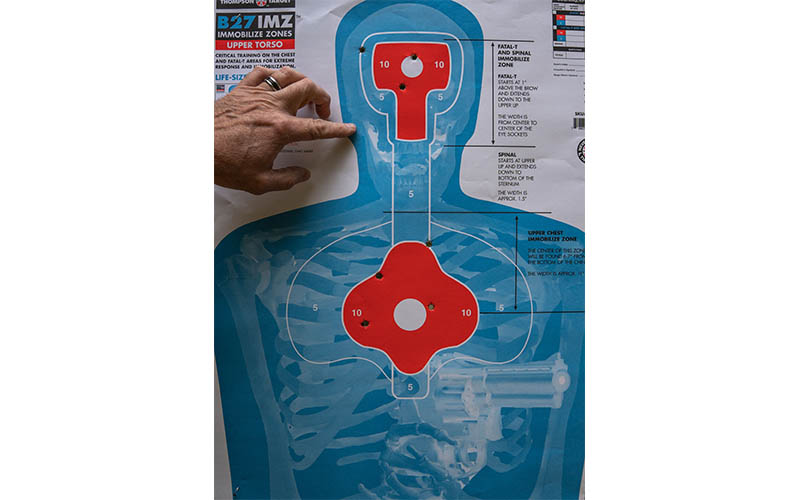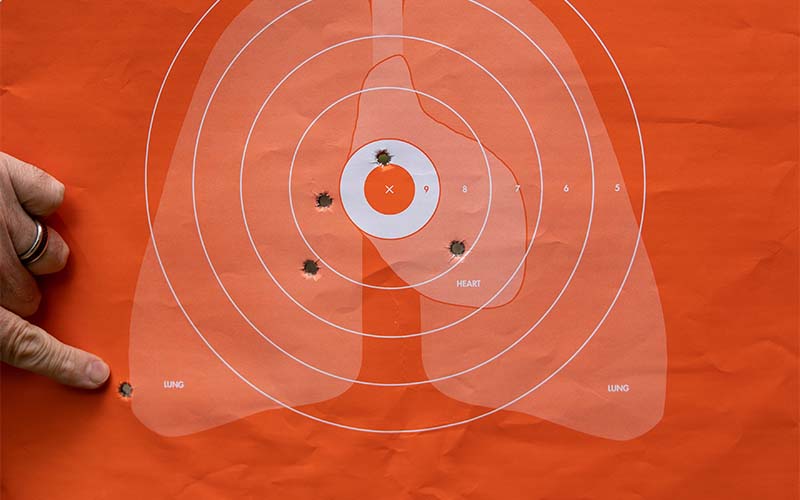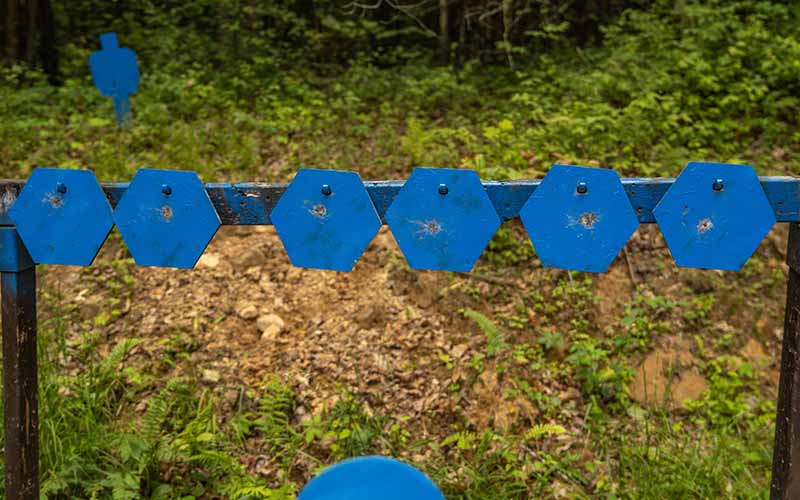
Which is better for sharpening your handgun skills, steel or paper targets?
When shooting a handgun, steel targets are the most fun to shoot. This is because they provide immediate audible feedback. And, depending on the target, they can also provide immediate visual feedback when the target moves. Another appealing feature of steel targets is that you don’t have to go downrange and paste up your bullet holes. Sure, you might want to paint them every now and again, but even that’s not mandatory. Steel targets are just easy to use and fun to shoot at. But are they the best target for training with a defensive handgun?
Yes and no. To conduct the best defensive handgun training, you need a variety of targets, some made of steel and some made of paper, and there are several reasons for this.

Basic Marksmanship Training
When you’re first learning to shoot a handgun, you’re primarily working to master sight alignment and trigger control. To do this, you need to know exactly where every bullet you shoot lands so that you can evaluate the influence your sight picture, trigger press, grip and every other element of marksmanship had on every shot. This is how you learn if you’re doing the right and the wrong things when you’re shooting.
For this type training, ideally, you’ll want a paper or cardboard target large enough that none of your shots miss the target and are lost. If you’re shooting at a small steel target, you’ll get that satisfaction of a hit. But if you miss the target, you won’t know where your miss went, and this makes determining your mistake difficult. Sure, you could use a large steel target but when shooting steel, it’s not as easy to see the exact points of impact.

Dynamic Drills
There are all sorts of dynamic drills that can be conducted with a defensive handgun. With dynamic drills, I’m talking about drills where you’re incorporating things like drawing from the holster, movement, reloading and multiple targets into the drill. For these types of drills, marksmanship matters, but in many cases, your focus is on gun handling—drawing the handgun, safely handling the handgun while moving, reloading and transitioning between targets.
I consider this type of shooting as advanced shooting, and it should only be conducted once you have a decent mastery of the basic marksmanship skills. In other words, you should be able to reliably hit what you’re shooting at before you embark on this type of training. For this type of work, pinpoint precision is not as important, and steel targets work exceptionally well. This is partly because of their immediate feedback, but also partly because you don’t have to stop your shooting, lose focus and paste your targets.

Tactical Drills
Tactically focused shooting is the logical next step once you’ve developed proficiency with basic marksmanship and dynamic shooting. Tactical drills should incorporate decision making, the use of cover and concealment and situational management. Tactical drills should also sometimes incorporate specific shot placement, because knowing where to shoot an attacker is a tactical consideration. For this type of training, I think both steel and paper can be effectively used for targets.
In fact, it might be best to start tactical training with steel targets so that you can focus more on what you’re doing than on how well you’re shooting. This is where a torso-shaped steel target can be beneficial. As your working through the problems, you know you’re getting your hits because of the audible feedback. The hits might not be great, but they’re hits. Once you become comfortable with the tactical elements of the drill, it’s a good idea to replace the steel targets with lifelike paper targets so that you can now concentrate on the tactics and on putting your bullets where they need to go.
Advanced Marksmanship Drills
As your shooting skills develop even more, you’ll begin to be able to call your shots. I’m talking about when the trigger breaks you should be able to reliably predict where the shot will land. Experience teaches this with evaluation of the sight picture and the trigger press when the shot was fired. Once your shooting is at this level, having a paper target to evaluate your shooting is not as important anymore, and using steel speeds up the training process with less time looking at the target and pasting holes.

For example, I often shoot at an 8-inch steel plate from extended distances. Because of experience, when I miss, I most often know that I pulled the shot low, high, right or left. If I was shooting at paper, the holes would provide the same information, but I’d have to walk down range too see if I hit or missed, and this would interrupt my training and focus. The problem with shooting at steel in instances like this is when you’re missing more than you’re hitting, and you don’t know where your misses are going.
Another example of an advanced marksmanship drill is one that includes dynamic action, like when shooting at a plate rack. Sure, you could line up six paper targets and shoot them very fast just as you would a steel plate rack. The problem is you’ll not know if you hit every paper plate until the drill is over and you go down range to score. With a steel plate rack, you get the feedback as you go so that you can make up missed shots.
Which Is Best?
I believe steel and paper targets are great for defensive handgun training. Both have their strengths and weaknesses. If you’re running a drill and you want to know whether steel or paper is the best target to use, here’s one way to decide. Run the drill two or three times on either steel or paper. If you’re not getting your hits in the desired area at least 80 to 85 percent of the time, you should probably be using a paper target so that you can see where your misses are going and potentially evaluate what you’re doing wrong. Also, and this is good to know, with most steel targets, you do not want to shoot at them closer than about 10 yards.
Editor's Note: This article originally appeared in the September 2023 issue of Gun Digest the Magazine.
More On Steel And Paper Targets:
- Selecting The Best Shooting Targets For Your Needs
- The Best Shooting Targets To Sharpen Your Handgun Skills
- 5 Best Steel Targets For Years Of Shooting Fun
- Why You Should Shoot AR500 Targets

Next Step: Get your FREE Printable Target Pack
Enhance your shooting precision with our 62 MOA Targets, perfect for rifles and handguns. Crafted in collaboration with Storm Tactical for accuracy and versatility.
Subscribe to the Gun Digest email newsletter and get your downloadable target pack sent straight to your inbox. Stay updated with the latest firearms info in the industry.

![Best Concealed Carry Guns In 2025 [Field Tested] Wilson Combat EDC X9S 1](https://gundigest.com/wp-content/uploads/Wilson-Combat-EDC-X9S-1-324x160.jpg)


![Best 9mm Carbine: Affordable PCCs [Tested] Ruger Carbine Shooting](https://gundigest.com/wp-content/uploads/Ruger-Carbine-Shooting-100x70.jpg)
![Best AR-15: Top Options Available Today [Field Tested] Harrington and Richardson PSA XM177E2 feature](https://gundigest.com/wp-content/uploads/Harrington-and-Richardson-PSA-XM177E2-feature-100x70.jpg)
